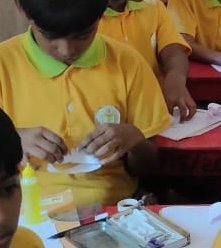🧬 I have been playing with the Math Circle model in rural Bengal for sometime. The goal has been to tweak the age-old Russian #mathcircle model to make it locally relevant and adapted with contemporary learning tools.
It has been a slow learning process for us. This post contains the present state of the model.
🔍 We usually start with a school visit (invited by an NGO, headmaster, teacher or a friend).
👨🏫 The mathematics teachers of the school are of great help. In the first visit we meet them. We explain the Math Circle flipped classroom model and the benefits of Mathematical Olympiads.
Teachers are usually not very enthusiastic in the beginning. They sometimes think that the ‘dream’ that we are selling is too lofty for these rural kids.
🔭Nevertheless in the first meeting we ask the teachers to find some kids who are ‘good at maths’ from grades 5 to 9.
We have noticed that kids below grade 5 are too hard to work with, given our limited resources. Kids above grade 9 are usually busy with board exams.
The local teachers are quite good at identifying the enthusiastic kids. Earlier we used to conduct ‘talent search workshops’. Now we have stopped that layer and depend completely upon the school teachers for student selection.
🛤️💺🎻 Usually in the second school visit we conduct an Introductory workshop with the set of selected enthusiastic kids. Over the years we have assembled some model questions and activities that are usueful for these workshops.
➕We often mention open problems such twin prime conjecture to expose the students to the fact – not all of math is known and they can possibly contribute new things some day.
➕We work with low-tool collaborative problems in small groups 4 – 6 kids and ask them to present solution. This goes really well.
➕Token gifts are handed out to the successful students and teams.
➕We usually incorporate attention clinching exercises such Kendoku and Masyu.
🛜 Next step is to start the weekly sessions online. Internet has spread quite well in rural Bengal. We have found active internet, projectors, computers even at remotely located government schools.

➕One session is a 'class' taught by a trained faculty. This is done within school hour (Friday).
➕Another session is a 'math circle' where 4 Cheenta students are paired up with 4 rural school students and they solve interesting low-tool problems together. This happens on a Sunday. Student attendance has been a constant challenge for this session.🪙 Local Teachers who are involved in the process are awarded a weekly stipend of ₹1000 provided
➕They themselves attended two of the classes
➕More than 80% of the students are present in both of the classes.
➕More than 50% kids are attending the homework.We continue to work harder to improve this working model. If you are interested to contribute in this process, feel free to join us. Lets hope that we can nurture the Perelmans of future from rural India.


Leave a Reply